Enhanced thermoelectric performance of F4-TCNQ doped FASnI3 thin films†
Abstract
In the past decade, great efforts have been devoted to the development of organic–inorganic hybrid perovskites for achieving efficient photovoltaics, but less attention has been paid to their thermoelectric applications. In this study, for the first time, we report the thermoelectric performance of 2,3,5,6-tetrafluoro-7,7,8,8-tetracyanoquinodimethane (F4-TCNQ) doped NH2CHNH2SnI3 (FASnI3) thin films. It is found that the electrical conductivities of the F4-TCNQ doped FASnI3 thin films increase and then decrease along with increased doping levels of F4-TCNQ. Systematic studies indicate that enhanced electrical conductivities are attributed to the increased charge carrier concentrations and mobilities and superior film morphologies of the F4-TCNQ doped FASnI3 thin films, and decreased electrical conductivities originate from the cracks and poor film morphology of the F4-TCNQ doped FASnI3 thin films induced by excess F4-TCNQ dopants. The quantitative thermal conductivity scanning thermal microscopy studies reveal that the F4-TCNQ doped FASnI3 thin films exhibit ultralow thermal conductivities. Moreover, the thermoelectric performance of the F4-TCNQ doped FASnI3 thin films is investigated. It is found that the F4-TCNQ doped FASnI3 thin films exhibit a Seebeck coefficient of ∼310 μV K−1, a power factor of ∼130 μW m−1 K−2 and a ZT value of ∼0.19 at room temperature. All these results demonstrate that our studies open a door for exploring cost-effective less-toxic organic–inorganic hybrid perovskites in heat-to-electricity conversion applications at room temperature.



 Please wait while we load your content...
Please wait while we load your content...
